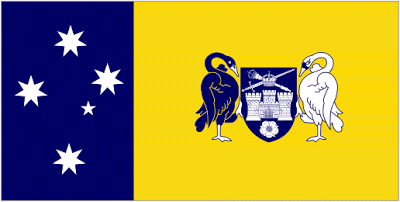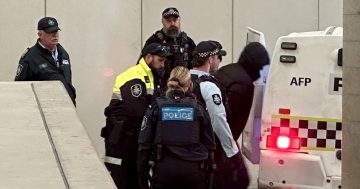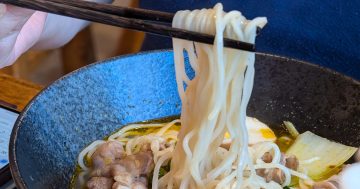
I want to wade into the issue of replacing our ACT Flag; a subject started by Steven Squires in an article earlier this month. I invite people to read or re-read that thread.
The comments offered in response to Steven varied from considered opinion to frivolous and mocking. Indeed, a serious question re the presence of the white swan was largely ignored. Credit to Dungfungus for outlining the actual reason for the presence of that coloured swan.
Just to reiterate that reason; it was to show that the two peoples, white and black, live together in the ACT and share in its sovereignty. The last part is my own interpretation.

The presence of the white swan is odd for two reasons. The first is, as Dungers quite rightly pointed out, there are no indigenous white swans in Australia. The second is the patronising demonstration of co-habitation instead of the theft of land and culture from our indigenous brothers and sisters.
Sure, we have signposts welcoming people to Ngunnawal country as one enters the ACT. But they were put there by a white administration from the Legislative Assembly. I don’t know any Ngunnawal or Ngambri people who necessarily share that welcome. It must be said however, that often we have welcome to country ceremonies with welcoming speeches by Ngunnawal elders inviting us to lay our footprints on their land. But even here, I reckon if they had their druthers, they would prefer some greater recognition of their traditional “ownership” to “custodianship”.
And sure, when the pollies start speeches (and indeed in some instances in NGOs) proceedings are started with an acknowledgment of the traditional custodians of the land. This poem is recited by folks who, I’m sure don’t always have its sentiment at heart.
So, in my mind, the swans can go from the flag. They really represent to me the occupation of the boundaries of the ACT by white folks to the detriment of the original owners of the land.
If you look at the pictures at the start of the article, you will see two different coats of arms. That they are different gives cause for a re-evaluation of the presence of the coat of arms at all on our Territorial symbolism. That the flag contains a “modified” coat of arms gives rise to questions of why was it necessary, and who said it was a good/bad idea?
Now is the time to stand on our own two feet and declare the individuality of the Territory, in much the same way as the NT did, and to sever connections with the Crown, once and for all.
Ivo Ostyn developed a few alternatives for a flag and put them into the public arena for discussion (and hopefully, adoption). Some are:

Note that there are a few images which invoke emotion of patriotism for the Territory. One is the colour scheme, and the other is the Southern Cross. No one seems to object to the blue and gold colour scheme as being inappropriate. I agree that we should embrace those colours because they, for me, do show our individuality and lend an instant recognition that we are not part of either NSW or Victoria, whose colour scheme seem to follow traditional pommie lines.
Ivo proposed a stylised version of the Royal (yuk) Bluebell to replace the coat of arms. Whilst disliking the label Royal, I do think that the Bluebell, being only found here, is a good call.
Back to the coat of arms. The reference to the British (and some say, the Australian) hereditary monarchy is abhorrent to me (please note that I was born in the UK, came here when I was 3 years old, and only go there to visit cousins. I feel no affiliation with the UK at all).
The references to the Crown are (obviously) in the true coat of arms – the crown is placed above the shield. Also, the rose is that of the monarchy. Interestingly, I read recently, that the rose symbol for the House of Windsor is actually a pink rose being a blend of the Lancastrian red rose and the Yorkshire white rose. But we have a white one on our coat of arms. Note also that there is another crown in the shield itself.
I must say that I don’t think we have too many castles in Australia lived in by major or minor royalty and I can thus only surmise that this also refers to an English aspect of the monarchy.
The scroll below the coat of arms reads “For the Queen, the Law and the People”. I’m happy about the latter two sentiments but not the “For the Queen” bit. Did you know that when Legislative Assembly members are sworn in they can swear allegiance to the Queen, her heirs and successors, or affirm their loyalty to the ACT and its people? No guesses for the way I affirmed my loyalty to the people of the ACT when I was sworn in.
Note here that the scroll is missing from the flag’s coat of arms.
Indeed, when the sitting periods commence each day in the Assembly, the Speaker asks members to stand in their place and pray or reflect on their responsibilities to the people of the Australian Capital Territory. No mention of the monarchy.
I think the ACT is ready for another considered discussion about its uniqueness, its sovereignty and the symbols which represent them.
The flag was inaugurated following a motion in the Legislative Assembly on March 25, 1993, after a competition and extensive conversation with the community. The process was quite robust but in none of the discussions I have been able to unearth is there a discussion on the modified coat of arms. Nor a conversation as to whether ties with the monarchy should be severed.
So, I say, let the conversation recommence. Let us take the opportunity to have another look at the flag and all that it connotes.
The ACT became the People’s Democratic Republic of the ACT in 1989, after much angst and venom in 1988. It will be 30 years old in 2019, the Territory will have been around for 106 years. Perhaps the timing for a change is nigh.
Interestingly, the flag can be changed by a mere motion carried by simple majority by the Legislative Assembly in much the same way as the original flag was created. So, perhaps those august legislators could be enticed to reconsider the flag and its connection with the people of the ACT rather than a hereditary monarchy, removed geographically and spiritually, from the peasantry.
I haven’t met Steven Squires but intend to do so very shortly. I have spoken to Ivo Ostyn and intend to meet with him shortly also. Anyone else interested in being part of a movement for change?

















